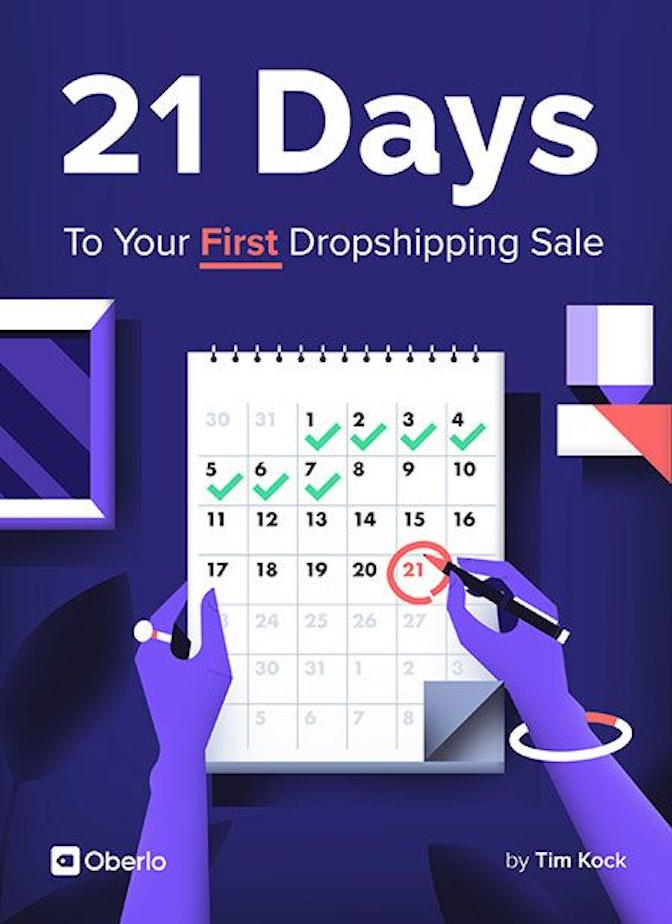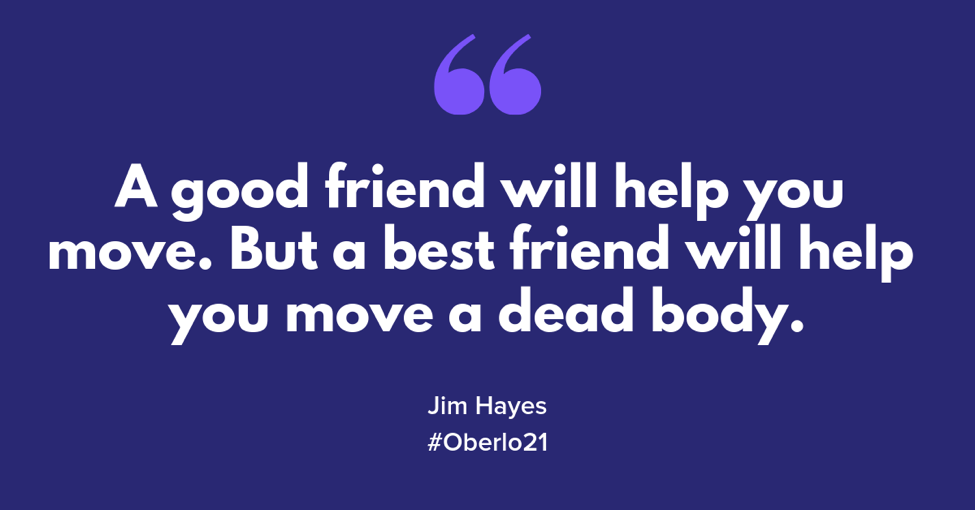
1. Tweet today’s quote → 2. Get to work!

With a great niche at your disposal, the next logical step is to build a supportive network of e-friends.
E-friends? I’m referring to the people who will support and engage with your store. Some of these people will be willing to promote it, while some will be interested in shopping.
In the ecommerce industry, some of your best e-friends might be the people who are known as ‘influencers.’
Every day leading up to your launch, we want to be posting something, somewhere to help build excitement for when the store actually launches. (But not spamming anyone, of course).
And the key to building these connections is through having authentic engagements with influencers, groups, and potential customers in your niche. Today will be the start of a critical daily engagement routine.
Aren’t you excited?
Today, we’re going to:
- Learn about and research micro-influencers
- Build a mini influencer database using the template we’ll give you
- Build a Facebook groups database using another template
- Join and start engaging with these Facebook groups in your niche
[highlight]LAST REMINDER: If you haven’t done it yet, remember to download your Calendar now, add your name with a marker, print it and hang it somewhere you can see it everyday. Snap a picture and post it on Instagram, hashtag: #Oberlo21.[/highlight]
Okay, let’s go.



What’s the deal with influencers?
For those unfamiliar with them, influencers exist on social networking platforms like Instagram.
They have the ability to affect the buying decisions of others because of their position, expertise, or knowledge about a particular niche.
→ Click Here to Launch Your Online Business with Shopify
As such, they are usually regarded as credible by the devotees of that niche.
What’s intriguing is that an influencer doesn’t have to be an Instagram superstar, a famous YouTuber, or a high-profile celebrity.
They could be everyday people like you and me, with the right connections and social authority.
Another name for these everyday influencers is ‘micro-influencers.’
They don’t have a massive social following to brag about, but are able to drive loads of engagement (as high as 60% compared to high-profile influencers) among their smaller, more engaged audiences.
Here’s a little more detail on how micro-influencers differ from conventional influencers:

The basic structure of working with micro-influencers is pretty straightforward: Give an influencer a free sample of your product and they’ll share the said product with their followers in return.
Most of the micro-influencers I’ve worked with follow this structure. Some, however, expect you to pay them before they post about your product or brand. The bigger their following and reach, the more likely they’ll want to be paid. This is part of why we’re shooting for micro-influencers to begin with.
Regardless of however you compensate them, they’re unlikely to want to work with someone who is ‘unappropriate’ for their audience.
Hence, you need to find micro-influencers who closely align with your brand.
And, honestly, that’s something you can’t do within a couple of hours, which is why I advised Amanda to dedicate an entire day to this task up-front. (Plus many more hours throughout the course of these 21 days.)
You should also join Facebook groups that have audiences with similar interests.
Unlike Facebook Pages, which require you to ‘boost’ content or create ads to reach people on a wider scale, Facebook groups allow you to reach everyone who is a part of those groups.
By joining Facebook groups relevant to your niche, you’ll make way for new channels that you can tap into for supporting and marketing your store.
If you want to find out more about influencer marketing, you’ll learn everything you need to know in our Complete Guide to Getting Started with Influencer Marketing.
How to find the right micro-influencers for your store
There are many social media platforms out there, and each of them contains micro-influencers. The most popular ones, as you likely know, are Instagram, YouTube, Facebook, and Snapchat.
Based on their niche, ecommerce entrepreneurs can run an influencer marketing campaign on one or a combination of these platforms.
The ideal platform for influencer marketing is the one where your target audience is.
For example, if you’re planning to dropship lawn trimmers, you’re more likely to find a target audience on YouTube. YouTube makes it easy to watch detailed tutorials of such products before making a purchase decision. In this case, you’d want to work with micro-influencers on YouTube.
Because Amanda had picked a fashion product to sell, she concentrated on Instagram.
By nature, Instagram fits the preferences of people to whom the visual and ‘experience’ dimensions are important: purchases generally associated with the feeling of immersing in an experience.
Fashion junkies can binge on the latest looks from runways, get style ideas, and witness new releases from their favorite brands. No wonder the average engagement rate for fashion brands is the highest on Instagram.
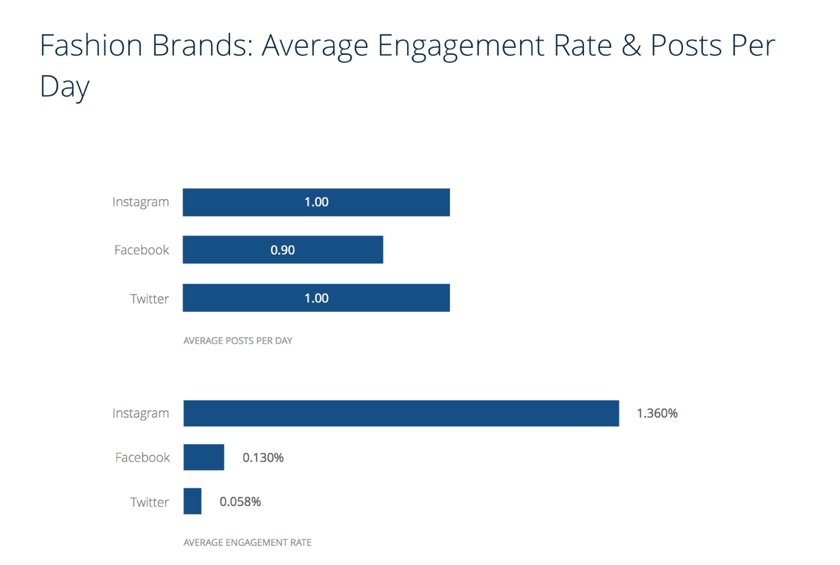
The even better aspect of Instagram? It lets you find relevant micro-influencers by searching for hashtags.
With her niche in mind, Amanda looked for people who recently posted an image with hashtags like #fashionaddict, #fall2018, #winterfashion, and #scarfstyle. The results that came up made it clear that female micro-influencers will be most suitable for her influencer marketing campaign.
For example, here’s the sort of content Amanda saw when she searched for #scarfstyle.
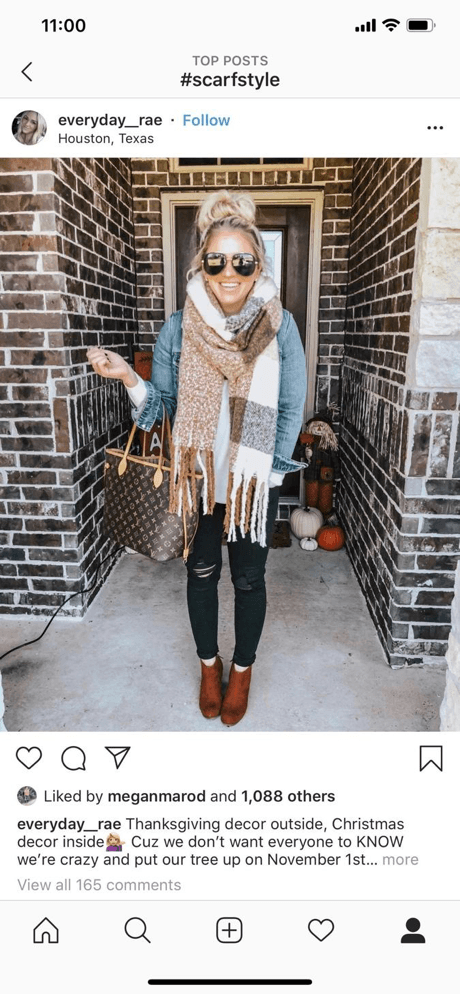
A quick look at this Instagrammer’s profile indicates that she is a micro-influencer (aka everyday person) with an engaged audience (over 150 people had commented on her scarf-related post).
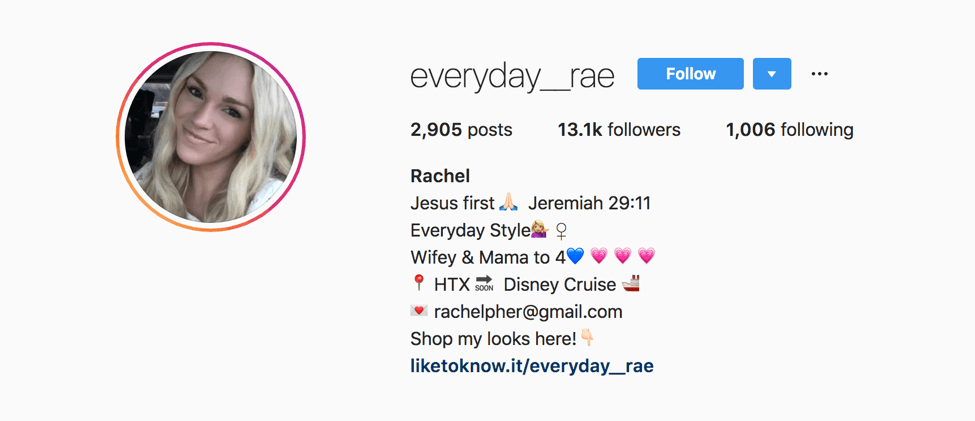
You can replicate the same strategy by searching for the hashtags related to your niche.
For quick hashtag ideas, use Hashtagify (it’s an online tool that allows you to find the right hashtags).
But, why did Amanda research influencers right after she chose a niche?
She wanted to ensure she already had a list of people to reach out and send products to when she starts pre-marketing for her store. This is also an incredibly valuable research into the niche, which you can use basically every day you’re on the grind trying to make sales.
[highlight]Start with a list of at least 20 micro-influencers that you can reach out to on Day 12 in preparation for your launch. Shoot for 10 to work with, but have a list of 20 ready because it’s pretty unlikely that every person you message will agree (some may not even respond!). Don’t overthink it for now – just focus on building a big list. On Day 12, we’ll go over what to really look for in a ‘good’ influencer before you start reaching out. [/highlight]
To make her list, Amanda searched for females who fit into these requirements:
- Have used a fashion-related hashtag
- Have received a minimum of 10% engagement from followers on recently posted content
- Have a minimum of 3,000 followers (preferably 5,000 or more though)
After an hour of scrolling through people’s feeds, Amanda came up with a rough list of female micro-influencers to reach out to. The next step was to get it organized.
Building a mini influencer database
As you begin to identify more potential influencers, create a mini Excel or Google Sheets database and input their information. This will help you later, as you reach out to the different influencers for potential collaborations and ship samples.
Here’s what I recommend to include in the database:
- Instagram handle
- Number of followers
- Editorial schedule (number of times they post in a day)
- Email ID (listed or not)
- Website link (mentioned or not)
- Location
Once you create an influencer database, easy access to your influencer’s information will save time and effort.
You won’t need to remember who you wanted to contact or analyze an influencer’s profile again in detail – you can just look it all up through your mini influencer database.
Here’s what the database looks like in Excel:

If you want to create something similar but don’t have much time, you can download and use the 2nd tab of our templates spreadsheet. The tab is titled ‘D2: Insta Database.’
You can create a similar database for YouTube, Facebook & Snapchat influencers. Consider building one to ensure you have all the information at hand when you’re pitching a collaboration idea or reaching out just to say hi.
As you’re searching, you’ll find loads of people who don’t quite fit the bill as an influencer – maybe they only have a couple hundred followers. But if they look like they would be a potential customer for your brand, add them to a separate list.
Later on, we’ll start a direct message marketing strategy where you’ll actually message potential customers. (FYI, my strategy is usually to ask them for feedback on the way my store looks, then offer them a discount code as a special ‘thank you.’ This technique has gotten me hundreds of customers! I’ll show you more about this on Day 15.)
Join Facebook groups
Once you’ve done with building an influencer database, it’s time to move toward Facebook groups.
As I mentioned earlier, Facebook groups give you access to the conversations started by your target audience.
Being a part of these conversations will help demonstrate your knowledge in areas relating to your niche. Plus, you’ll have a useful resource that you can tap into for all kinds of promotional activity.
The main way we’ll use these groups is to post your giveaway on Day 6. But there’s a lot of value in them otherwise when you can tap into the right groups.
Of course, the Facebook groups you join need to be relevant to your niche.
If you don’t have a clue about how to find such groups, follow these steps:
- Write the name of your niche in Facebook’s search bar.
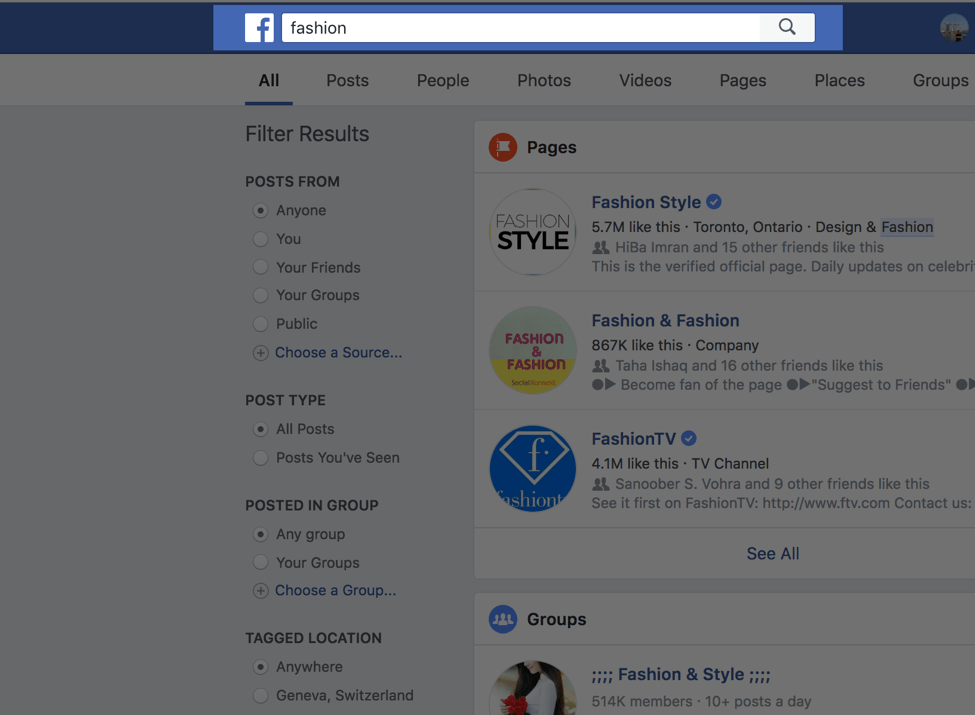
- Click the ‘Groups’ tab.
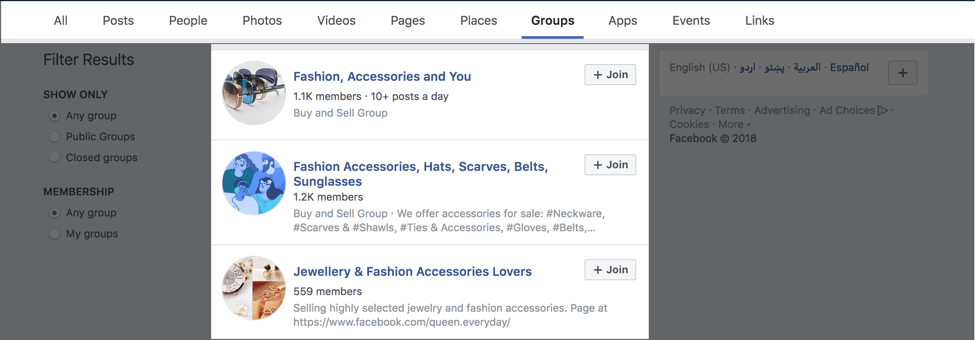
You should now see a list of groups that are relevant to your niche.
That’s all.
Start interacting in the group to get them warmed up and familiar with your name. This way, it won’t look like you’re spamming them when you want to promote your store.
If the group admin says new members aren’t allowed to post links, aim for value-based communication for at least a couple of months before making an attempt to post about a giveaway or product.
Be picky about the groups you join. If the content posted in a group feels like spam or there’s no engagement, you’re unlikely to drive traffic from the group. Limit your efforts to quality groups.
Amanda, for example, could look at how many members a group had, the engagement on posts in those groups, and how she could incorporate a giveaway into a post that provides value to the members of those groups.
Moreover, she could create a mini database for Facebook groups, like she had done for influencers, to keep things organized.
The database could be a simple one like this:

You can create one for your own niche by downloading and using the 3rd tab of our templates spreadsheet. The tab is titled ‘D2: Facebook Database.’
I recommend joining and becoming an active member of several Facebook groups.
Aim for ones with a big audience count and good engagement, instead of a hundred small groups.
And always keep this in mind: becoming a credible member of the group will take time and dedication. You really need to be able to add value to the group before they’ll want to buy things from you, so don’t just go selling right off the bat. Engage with them and ‘fit in.’
Be patient, and keep working on building relationships with the different members of the group – that’s the key to establishing credibility.
[highlight]Like I mentioned earlier, this is something you’ll want to work on every single day. From now on, dedicate at least 30 minutes every day to joining groups and engaging with them authentically.[/highlight]



Day 2 Recap
Today, you:
✓ Identified micro-influencers that you’ll collaborate with to hype up your store’s launch
✓ Built a mini influencer database that you’ll be able to reference later
✓ Took note of lots of potential customers, who you’ll be able to direct message later
✓ Got a better understanding of how Facebook groups work, and how you could leverage them for pre-marketing
Awesome. See you tomorrow.

